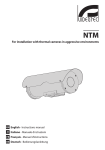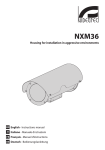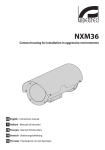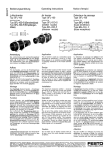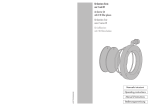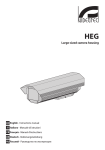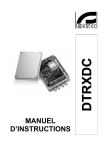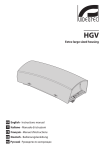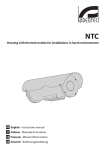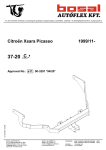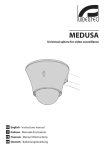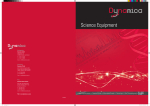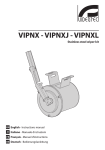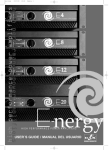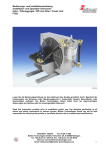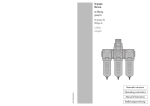Download Housing for installation in aggressive environments
Transcript
NXM
Housing for installation in aggressive environments
EN English - Instructions manual
IT Italiano - Manuale di istruzioni
FR Français - Manuel d'instructions
DE Deutsch - Bedienungslanleitung
NXM
Housing for installation in aggressive environments
EN English - Instructions manual
Contents
EN - English - Instructions manual
ENGLISH
1 About this manual......................................................................................................... 3
1.1 Typographical conventions................................................................................................................................. 3
2 Notes on copyright and information on trademarks................................................. 3
3 Safety rules.................................................................................................................... 3
4 Identification................................................................................................................. 3
4.1 Product description and type designation.................................................................................................... 3
4.2 Product markings.................................................................................................................................................... 3
5 Preparing the product for use...................................................................................... 4
5.1 Contents and unpacking...................................................................................................................................... 4
5.2 Safely disposing of packaging material.......................................................................................................... 4
6 Assembling and installing............................................................................................ 4
6.1 Installation................................................................................................................................................................. 4
6.1.1 How to open the housing.................................................................................................................................................... 4
6.1.2 How to install the camera.................................................................................................................................................... 4
6.1.2.1 Version 12Vdc/24Vac................................................................................................................................................................................... 5
6.1.2.2 Version 115/230Vac..................................................................................................................................................................................... 5
6.1.3 Installing the housing............................................................................................................................................................ 5
6.1.3.1 Sunshield mounting (if equipped)......................................................................................................................................................... 5
6.1.4 Installing the air barrier......................................................................................................................................................... 6
6.1.5 Heater.......................................................................................................................................................................................... 6
7 Maintaining and cleaning............................................................................................. 6
7.1 Window and plastic cover cleaning (PC)......................................................................................................... 6
8 Disposal of waste materials.......................................................................................... 7
9 Technical data................................................................................................................ 7
9.1 General........................................................................................................................................................................ 7
9.2 Mechanical................................................................................................................................................................. 7
9.3 Electrical..................................................................................................................................................................... 7
9.4 Environment.............................................................................................................................................................. 7
9.5 Certifications............................................................................................................................................................. 7
10 Technical drawings...................................................................................................... 8
2
• The device must be installed only and exclusively
by qualified technical personnel.
Before installing and using this unit, please read this
manual carefully. Be sure to keep it handy for later
reference.
• Before any technical work on the appliance,
disconnect the power supply.
1.1 Typographical conventions
DANGER!
High level hazard.
Risk of electric shock. Disconnect the
power supply before proceeding with any
operation, unless indicated otherwise.
gg
WARNING!
Medium level hazard.
This operation is very important for the
system to function properly. Please read
the procedure described very carefully and
carry it out as instructed.
hh
INFO
Description of system specifications.
We recommend reading this part carefully
in order to understand the subsequent
stages.
jj
2 Notes on copyright and
information on trademarks
The quoted names of products or companies are
trademarks or registered trademarks.
3 Safety rules
The manufacturer declines all responsibility
for any damage caused by an improper use
of the appliances mentioned in this manual.
Furthermore, the manufacturer reserves
the right to modify its contents without any
prior notice. The documentation contained
in this manual has been collected with great
care, the manufacturer, however, cannot
take any liability for its use. The same thing
can be said for any person or company
involved in the creation and production of
this manual.
hh
• Do not use power supply cables that seem worn
or old.
• Never, under any circumstances, make any
changes or connections that are not shown in
this handbook: improper use of the appliance
can cause serious hazards, risking the safety of
personnel and of the installation.
• Use only original spare parts. Not original spare
parts could cause fire, electrical discharge or other
hazards.
• Before proceeding with installation check the
supplied material to make sure it corresponds
to the order specification by examining the
identification labels ("4.2 Product markings", page 3).
4 Identification
4.1 Product description and type
designation
The NXM housing, entirely constructed from AISI 316
electropolished stainless steel, is designed to operate
in special environments such as marine, industrial,
chemical and where the external conditions are
highly corrosive.
The NXM housing consists of a 130mm diameter
cylindrical body enclosed by two 9mm thick circular
flanges. The back flange is equipped with two
PG13.5 cable glands for external connections. The
housing can be equipped with a flange designed to
create an air barrier in front of the glass to prevent
the formation of dust deposits. With the optional
air barrier, the filter group is recommended, which
purifies the air drawn from a compressor.
A wide range of accessories is available: heater,
camera power supply, stainless steel special bracket,
and the possibility of mounting the wiper and
washer.
The housing can be equipped with a double heater
for temperatures down to -40°C (-40°F).
4.2 Product markings
See the label attached to the outside of the package.
3
EN - English - Instructions manual
1 About this manual
EN - English - Instructions manual
5 Preparing the product
for use
Any change that is not expressly approved
by the manufacturer will invalidate the
guarantee.
hh
5.1 Contents and unpacking
When the product is delivered, make sure that the
package is intact and that there are no signs that it
has been dropped or scratched.
6 Assembling and
installing
Only specialised personnel should be
allowed to assemble and install the device.
hh
6.1 Installation
6.1.1 How to open the housing
To open the housing, unscrew the bolts on the front
bottom, using the hexagonal spanner supplied.
If there are obvious signs of damage, contact the
supplier immediately.
Keep the packaging in case you need to send the
product for repairs.
Check the contents to make sure they correspond
with the list of materials as below:
• NXM housing
• Housing equipment:
• Allen wrench
Fig. 01
Remove the bottom of the housing.
• Spacers
• Screws and washers
• Screws for camera
• Instructions manual
5.2 Safely disposing of
packaging material
The packaging material can all be recycled. The
installer technician will be responsible for separating
the material for disposal, and in any case for
compliance with the legislation in force where the
device is to be used.
Bear in mind that if the material has to be returned
due to a fault, using the original packaging for its
transport is strongly recommended.
Fig. 02
6.1.2 How to install the camera
This chapter described how to install the camera into
the housing.
Open the housing as described previously.
Fit the camera on the slide, using the insulating plate
and the supplied 1/4” screw. If necessary, use the
spacers to position the camera and optics correctly.
Fig. 03
4
Feed the cables through the cable grip, and make the
necessary electrical connections, ensuring that the
cable grips are holding firmly.
When the power supply voltage is 24Vac the circuit
will be connected by the terminals shown.
IN 12Vdc/24Vac
OUT 12Vdc/24Vac
Heater OUT 12Vdc/24Vac
Fig. 04
This section describes how to install the housing on
the wall bracket or on the Pan & Tilt head.
EN - English - Instructions manual
6.1.2.1 Version 12Vdc/24Vac
6.1.3 Installing the housing
Be sure to have rightly fitted the internal slide of the
housing according to the installation required. The
housing base must be fitted under the housing in
case of wall bracket mounting and on the housing
side in case of Pan & Tilt head mounting.
Fig. 06
Wall bracket.
Fig. 07
Pan & tilt.
6.1.2.2 Version 115/230Vac
When the power supply voltage is 115/230Vac the
circuit will be connected by the terminals shown.
IN 115/230Vac
6.1.3.1 Sunshield mounting (if equipped)
OUT 115/230Vac
Heater OUT 115/230Vac
Screw the equipped exagonal mounting spacers
on the side-flanges of the housing in diametrically
opposite position and according to the mounting
required, in order to mount the sunshield above the
housing. Fit the sunshield on the housing and fix it
with the equipped screw on the spacers.
Fig. 05
Before closing the housing reinsert the bottom
orientating the slide according to the installation
required, on the wall bracket (Fig. 06, page 5) or on the
Pan & tilt (Fig. 07, page 5) head, for the right camera
fitting.
Close the housing, taking care not to damage the
seals (ensure that they are correctly fitted in their
respective positions).
Fig. 08
Mount the housing on the wall bracket (Fig. 06, page 5)
or on the Pan & Tilt head bracket (Fig. 07, page 5).
5
EN - English - Instructions manual
6.1.4 Installing the air barrier
Unscrew the frontal bottom screw of the housing
using the equipped hexagonal wrench. Remove the
frontal flange and the standard glass.
The maximum air pressure to be supplied to the air
barrier is 2,5 BAR. The following experimental data
give the effective air consumption, for calculating the
size of the compressor.
Compressed air
pressure [bar]
Air barrier
consumption [m3/h]
1
7
1.5
10
2
12
2.5
14
Tab. 01
6.1.5 Heater
Fig. 09
Insert the tempered glass in the air barrier seat after
the right fitting of the gaskets. The gaskets on the
frontal part of the housing are 3.
Some models of NXM housing are equipped with
heater and double heater.
Close the housing frontal flange being careful not to
damage the closing gaskets.
Insert the compressed air tube in the relevant 1/4”
GAS pipe fitting on the air barrier.
Fig. 12
Fig. 10
We recommend using the optional filter unit for
cleaning the compressed air.
Fig. 13
7 Maintaining and cleaning
Fig. 11
NXFIGRU.
7.1 Window and plastic cover
cleaning (PC)
We suggest to use neutral soap diluted with water
or specific products for lens cleaning applied with a
soft cloth.
Avoid ethyl alcohol, solvents, hydrogenated
hydrocarbide, strong acid and alkali. Such
products may irreparably damage the
surface.
hh
6
8 Disposal of waste
materials
External dimensions: Ø 154mm (6in) length 370mm
(14.5in)
Internal usable area (WxH): 88x86mm (3.5x3.4in)
nn
Internal usable area with double heater (WxH):
55x100mm (2.2x3.9in)
Your product is designed and manufactured with
high quality materials and components which can be
recycled and reused.
Internal usable length with heater and/or power supply
This symbol means that electrical and electronic
equipment, at their end-of-life, should be disposed of
separately from your household waste.
9.3 Electrical
Please dispose of this equipment at your local
Community waste collection or Recycling centre.
In the European Union there are separate collection
systems for used electrical and electronic products.
9 Technical data
9.1 General
Constructed from electropolished stainless steel
(Austenitic alloy stainless steel, corrosion and heat
resistant according to the following standards):
-- UNI 6900-71: X 2 Cr Ni Mo 17 12
-- AISI: 316
-- DIN 17006: X 2 Cr Ni Mo 18 10
-- N° WERKSTOFF: 1.4404
-- AFNOR: Z2 CND 17-12
-- BSI: 316 S 12
The screws utilised are in austenitic alloy stainless steel,
corrosion and heat resistant according to the following
standards:
EN - English - Instructions manual
This symbol mark and recycle system
are applied only to EU countries and not
applied to the countries in the other area of
the world.
internal Ø 95mm (3.7in), external Ø 116mm (4.6in)
Internal usable length
NXM
NXM
334mm (13.1in)
245mm (9.6in)
Unit weight: 6kg / 13.3lb
Heater Ton 15°C±3°C (59°F ±5°F) Toff 22°C±3°C (71.6°F
±5°F)
-- IN 12Vdc/24Vac, consumption 20W max
-- IN 115/230Vac, consumption 40W max
-- IN 115/230Vac, double heater, consumption 80W
max
Camera power supply
-- IN 100-240Vac - OUT 12Vdc, 50/60Hz, 1A
-- IN 230Vac - OUT 24Vac, 50/60Hz, 400mA
9.4 Environment
Indoor / Outdoor
Submersible up to -50m (-164ft) (5 Bar pressure)
Operating temperature with heater: -20°C / +60°C (-4°F
/ +140°F)
Operating temperature with double heater: -40°C / +
60°C (-40°F / +140°F)
9.5 Certifications
CE EN61000-6-3, EN60065, EN50130-4
IP66/IP68 EN60529 IP66/IPx8 (5 Bar for 48 hours)
-- UNI 6900: X 5 Cr Ni Mo 1712
-- AISI: 316
-- ISO quality: A4
-- Resistance class ISO: 80
Supplied with instruction manual, desiccant bag,
accessories for camera and lens mounting
UNI: Ente Nazionale Italiano di Unificazione, AISI: American Iron and
Standard Institute, DIN: Deutsche Industrie Normen, AFNOR: Association
Française de Normalisation, BSI: British Standard Institution, ISO:
International Organization for Standardization.
9.2 Mechanical
2xPG13.5 cable glands in nickel-plated brass for external
connections
9mm (0.35in) thick front and back flanges
External body polishing
O-ring gaskets
Tempered window glass: 4mm (0.15in) thick, internal Ø
97mm (3.8in); external Ø 112mm (4.4in); with air barrier
7
10 Technical drawings
The values are in millimeters.
jj
POWER SUPPLY
164
Ø 154
245
A
USABLE AREA
A-A
A
97
334
352
182
CIRCUIT
88
460
86
B
USABLE
AREA
B-B
370
Fig. 14
NXM
VIDEOTEC S.p.A.
www.videotec.com
Printed in Italy
MNVCNXM_1044_EN
B
100
NXM
Custodia per installazioni in ambienti aggressivi
IT Italiano - Manuale di istruzioni
Sommario
ITALIANO
1 Informazioni sul presente manuale............................................................................. 3
IT - Italiano - Manuale di istruzioni
1.1 Convenzioni tipografiche..................................................................................................................................... 3
2 Note sul copyright e informazioni sui marchi commerciali....................................... 3
3 Norme di sicurezza........................................................................................................ 3
4 Identificazione............................................................................................................... 3
4.1 Descrizione e designazione del prodotto...................................................................................................... 3
4.2 Marcatura del prodotto......................................................................................................................................... 3
5 Preparazione del prodotto per l'utilizzo..................................................................... 4
5.1 Contenuto e disimballaggio................................................................................................................................ 4
5.2 Smaltimento in sicurezza dei materiali di imballaggio.............................................................................. 4
6 Assemblaggio e installazione....................................................................................... 4
6.1 Installazione.............................................................................................................................................................. 4
6.1.1 Apertura della custodia........................................................................................................................................................ 4
6.1.2 Installazione della telecamera............................................................................................................................................ 4
6.1.2.1 Versione 12Vdc/24Vac................................................................................................................................................................................ 5
6.1.2.2 Versione 115/230Vac................................................................................................................................................................................... 5
6.1.3 Installazione della custodia................................................................................................................................................. 5
6.1.3.1 Montaggio tettuccio parasole (se in dotazione)............................................................................................................................... 5
6.1.4 Installazione barriera d’aria................................................................................................................................................. 6
6.1.5 Riscaldamento.......................................................................................................................................................................... 6
7 Manutenzione e pulizia................................................................................................ 6
7.1 Pulizia del vetro e delle parti in plastica (PC)................................................................................................. 6
8 Smaltimento dei rifiuti.................................................................................................. 7
9 Dati tecnici..................................................................................................................... 7
9.1 Generale..................................................................................................................................................................... 7
9.2 Meccanica.................................................................................................................................................................. 7
9.3 Elettrico....................................................................................................................................................................... 7
9.4 Ambiente.................................................................................................................................................................... 7
9.5 Certificazioni............................................................................................................................................................. 7
10 Disegni tecnici............................................................................................................. 8
2
1 Informazioni sul presente
manuale
1.1 Convenzioni tipografiche
PERICOLO!
Pericolosità elevata.
Rischio di scosse elettriche. Togliere
l'alimentazione prima di procedere con le
operazioni, salvo diversa indicazione.
gg
ATTENZIONE!
Pericolosità media.
L'operazione è molto importante per il
corretto funzionamento del sistema. Si
prega di leggere attentamente la procedura
indicata e di eseguirla secondo le modalità
previste.
hh
INFO
Descrizione delle caratteristiche del
sistema.
Si consiglia di leggere attentamente per
comprendere le fasi successive.
jj
2 Note sul copyright e
informazioni sui marchi
commerciali
I nomi di prodotto o di aziende citati sono marchi
commerciali o marchi commerciali registrati
appartenenti alle rispettive società.
3 Norme di sicurezza
Il produttore declina ogni responsabilità
per eventuali danni derivanti da un
uso improprio delle apparecchiature
menzionate in questo manuale. Si
riserva inoltre il diritto di modificarne il
contenuto senza preavviso. Ogni cura è
stata posta nella raccolta e nella verifica
della documentazione contenuta in questo
manuale, tuttavia il produttore non può
assumersi alcuna responsabilità derivante
dall'utilizzo della stessa. Lo stesso dicasi
per ogni persona o società coinvolta nella
creazione e nella produzione di questo
manuale.
hh
• Prima di effettuare interventi tecnici
sull'apparecchio togliere l'alimentazione elettrica.
• Non utilizzare cavi di alimentazione con segni di
usura o invecchiamento.
• Non effettuare per nessun motivo alterazioni o
collegamenti non previsti in questo manuale:
l'uso di apparecchi non idonei può portare a
gravi pericoli per la sicurezza del personale e
dell'impianto.
• Utilizzare solo parti di ricambio originali. Pezzi di
ricambio non originali potrebbero causare incendi,
scariche elettriche o altri pericoli.
• Prima di procedere con l'installazione controllare
che il materiale fornito corrisponda alle specifiche
richieste esaminando le etichette di marcatura ("4.2
Marcatura del prodotto", pagina 3).
4 Identificazione
4.1 Descrizione e designazione
del prodotto
La custodia NXM, interamente costruita in acciaio
Inox brillantato AISI 316, è stata progettata per
applicazioni speciali come quella marina, industriale,
chimica o in ambienti dove gli agenti esterni sono
particolarmente corrosivi.
La custodia NXM ha un corpo cilindrico di diametro
130mm chiuso da due flange circolari di 9mm di
spessore. Sulla flangia posteriore sono presenti 2
pressacavi PG13.5 per le connessioni esterne. La
custodia può essere dotata di una flangia predisposta
per creare una barriera d’aria davanti al vetro con
lo scopo di impedire il deposito di polvere. Con
la barriera d'aria si consiglia di usare il gruppo
filtri per pulire l'aria, solitamente prelevata da un
compressore.
Numerosi gli accessori disponibili, che vanno dal
riscaldamento, all’alimentatore per telecamera, al
supporto speciale da parete, e alla possibilità di
montare il lavavetro ed il tergicristallo.
La custodia può essere equipaggiata con un doppio
riscaldamento per temperature fino a -40°C.
4.2 Marcatura del prodotto
Vedere l’etichetta posta sull’esterno dell’imballo.
3
IT - Italiano - Manuale di istruzioni
Prima di installare e utilizzare questa unità, leggere
attentamente questo manuale. Conservare questo
manuale a portata di mano come riferimento futuro.
• L'installazione e la manutenzione del dispositivo
deve essere eseguita solo da personale tecnico
qualificato.
5 Preparazione del
prodotto per l'utilizzo
Qualsiasi cambiamento non espressamente
approvato dal costruttore fa decadere la
garanzia.
IT - Italiano - Manuale di istruzioni
hh
5.1 Contenuto e disimballaggio
Alla consegna del prodotto verificare che l'imballo
sia integro e non abbia segni evidenti di cadute o
abrasioni.
In caso di evidenti segni di danno all'imballo
contattare immediatamente il fornitore.
6 Assemblaggio e
installazione
L'assemblaggio e l'installazione vanno
eseguiti solo da personale specializzato.
hh
6.1 Installazione
6.1.1 Apertura della custodia
Per l’apertura della custodia svitare le viti poste sul
fondo posteriore utilizzando la chiave esagonale in
dotazione.
Conservare l'imballo nel caso sia necessario inviare il
prodotto in riparazione.
Controllare che il contenuto sia rispondente alla lista
del materiale sotto indicata:
• Custodia NXM
• Dotazione per custodia:
• Chiave a brugola
• Distanziali
Fig. 01
Sfilare il fondo della custodia.
• Viti e rondelle
• Viti per telecamera
• Manuale di istruzioni
5.2 Smaltimento in sicurezza dei
materiali di imballaggio
I materiali d'imballo sono costituiti interamente da
materiale riciclabile. Sarà cura del tecnico installatore
smaltirli secondo le modalità di raccolta differenziata
o comunque secondo le norme vigenti nel Paese di
utilizzo.
Fig. 02
Si ricorda comunque che in caso di ritorno di
materiale con malfunzionamenti è consigliato
l'imballaggio originale per il trasporto.
Aprire la custodia come precedentemente descritto.
6.1.2 Installazione della telecamera
Questa sezione descrive come installare la telecamera
all’interno della custodia.
Montare la telecamera sulla slitta utilizzando la
piastrina isolante e la vite da 1/4” in dotazione. Se
necessario utilizzare i distanziali per posizionare nel
modo corretto telecamera ed ottica.
Fig. 03
4
Inserire i cavi attraverso i pressacavi ed eseguire le
connessioni elettriche necessarie, assicurarsi che i
pressacavi siano fissati saldamente.
6.1.2.1 Versione 12Vdc/24Vac
IN 12Vdc/24Vac
OUT 12Vdc/24Vac
Questa sezione descrive come installare la custodia
su staffa a parete o su brandeggio.
Assicurarsi durante la chiusura di aver orientato
correttamente la slitta interna della custodia in
funzione del tipo di installazione. La base della
custodia deve essere posizionata sotto la stessa nel
caso di montaggio su staffa a parete mentre è posta
lateralmente alla custodia nel caso di montaggio su
brandeggio.
IT - Italiano - Manuale di istruzioni
Il circuito risulterà connesso tramite i morsetti
indicati nel caso di tensione di alimentazione del
riscaldamento di 24Vac.
6.1.3 Installazione della custodia
Heater OUT 12Vdc/24Vac
Fig. 04
Fig. 06
Staffa a parete.
Fig. 07
Brandeggio.
6.1.2.2 Versione 115/230Vac
Il circuito risulterà connesso tramite i morsetti
indicati nel caso di tensione di alimentazione del
riscaldamento di 115/230Vac.
IN 115/230Vac
6.1.3.1 Montaggio tettuccio parasole (se in
dotazione)
OUT 115/230Vac
Heater OUT 115/230Vac
Fig. 05
Prima di richiudere la custodia reinserire il
fondo orientando la slitta in funzione del tipo di
installazione, su staffa a parete (Fig. 06, pagina 5)
oppure su brandeggio (Fig. 07, pagina 5) in modo che
la telecamera risulti posizionata correttamente.
Avvitare i distanziali esagonali di fissaggio in
dotazione sulle flange laterali della custodia in
posizioni diametralmente opposte ed in funzione
del tipo di installazione in modo tale che il tettuccio
risulti montato sulla parte superiore della custodia.
Posizionare il tettuccio sulla custodia e fissarlo con
le viti in dotazione in corrispondenza dei distanziali
precedenti.
Chiudere la custodia prestando attenzione a non
danneggiare la guarnizione di tenuta (assicurarsi che
sia correttamente inserita nella propria sede).
Fig. 08
Montare la custodia sulla staffa a parete (Fig. 06,
pagina 5) oppure sulla staffa del brandeggio (Fig. 07,
pagina 5).
5
6.1.4 Installazione barriera d’aria
Svitare le viti poste sul fondo anteriore della custodia
utilizzando la chiave esagonale in dotazione. Togliere
la flangia anteriore ed il vetro standard.
La pressione massima dell’aria da fornire alla
barriera d’aria è di 2,5 BAR. I seguenti dati
sperimentali forniscono il consumo d’aria utile per il
dimensionamento del compressore.
IT - Italiano - Manuale di istruzioni
Pressione aria
compressa [bar]
Consumo barriera
d’aria [m3/h]
1
7
1.5
10
2
12
2.5
14
Tab. 01
6.1.5 Riscaldamento
Fig. 09
Inserire il vetro temperato nella sede della barriera
d’aria dopo aver posizionato correttamente le
guarnizioni di tenuta. Le guarnizioni presenti sul
frontale della custodia sono 3.
Alcuni modelli della custodia NXM sono dotati di
riscaldamento normale e doppio.
Chiudere il frontale della custodia prestando
attenzione a non danneggiare le guarnizioni di
chiusura (assicurarsi che siano correttamente inserite
nelle proprie sedi).
Innestare il tubo dell’aria compressa nell’apposito
raccordo da 1/4” GAS presente sulla barriera d’aria.
Fig. 12
Fig. 10
Si consiglia l’utilizzo del gruppo filtri opzionale per la
pulizia dell’aria compressa.
Fig. 13
7 Manutenzione e pulizia
7.1 Pulizia del vetro e delle parti
in plastica (PC)
Fig. 11
NXFIGRU.
Si consigliano saponi neutri diluiti con acqua o
prodotti specifici per la pulizia delle lenti degli
occhiali con l’utilizzo di un panno morbido.
Sono da evitare alcool etilico,solventi,
idrocarburi idrogenati, acidi forti e alcali.
L’utilizzo di detti prodotti danneggia in
modo irreparabile la superficie trattata.
hh
6
8 Smaltimento dei rifiuti
Questo simbolo e il sistema di riciclaggio
sono validi solo nei paesi dell'EU e non
trovano applicazione in altri paesi del
mondo.
nn
Prodotti elettrici ed elettronici che portano questo
simbolo alla fine dell'uso devono essere smaltiti
separatamente dai rifiuti casalinghi.
Vi preghiamo di smaltire questo apparecchio in un
Centro di raccolta o in un'Ecostazione.
Nell'Unione Europea esistono sistemi di raccolta
differenziata per prodotti elettrici ed elettronici.
9 Dati tecnici
9.1 Generale
Costruita in acciaio Inox brillantato (Acciaio legato
austenitico inossidabile resistente alla corrosione e al
calore):
-- UNI 6900-71: X 2 Cr Ni Mo 17 12
-- AISI: 316
-- DIN 17006: X 2 Cr Ni Mo 18 10
-- N° WERKSTOFF: 1.4404
Dimensioni utili interne con doppio riscaldamento
(WxH): 55x100mm
Lunghezza utile interna senza accessori
NXM
334mm
Lunghezza utile interna con riscaldamento e/o
alimentatore
NXM
245mm
Peso unitario: 6kg
9.3 Elettrico
Riscaldamento Ton 15°C±3°C Toff 22°C±3°C
-- IN 12Vdc/24Vac, consumo 20W max
-- IN 115/230Vac, consumo 40W max
-- IN 115/230Vac, doppio riscaldamento consumo 80W
max
Alimentatore per telecamera
-- IN 100-240Vac - OUT 12Vdc, 50/60Hz, 1A
-- IN 230Vac - OUT 24Vac, 50/60Hz, 400mA
9.4 Ambiente
Interno / Esterno
Sommersione fino a -50m (pressione 5 Bar)
Temperatura di esercizio con riscaldamento: -20°C /
+60°C
Temperatura di esercizio con doppio riscaldamento:
-40°C / +60°C
-- AFNOR: Z2 CND 17-12
9.5 Certificazioni
-- BSI: 316 S 12
CE EN61000-6-3, EN60065, EN50130-4
Viteria impiegata è realizzata in acciaio legato austenitico
inossidabile resistente alla corrosione e al calore:
IP66/IP68 EN60529 IP66/IPx8 (5 Bar per 48 ore)
-- UNI 6900: X 5 Cr Ni Mo 1712
-- AISI: 316
-- Qualità ISO: A4
-- Classe di resistenza ISO: 80
Fornita con manuale di istruzioni, sacchetto sale,
accessori montaggio telecamera e obiettivo
UNI: Ente Nazionale Italiano di Unificazione, AISI: American Iron and
Standard Institute, DIN: Deutsche Industrie Normen, AFNOR: Association
Française de Normalisation, BSI: British Standard Institution, ISO:
International Organization for Standardization.
9.2 Meccanica
2xPG13.5 pressacavi in ottone nichelato per le
connessioni esterne
Due flange anteriore e posteriore di 9mm
Brillantatura esterna corpo
Guarnizioni O-ring a tenuta elevata
Finestra in vetro temperato: spessore 4mm, Ø interno
97mm, Ø esterno 112mm (con barriera d’aria Ø interno
95mm, Ø esterno 116mm)
Dimensioni esterne: Ø 154mm, lunghezza 370mm
7
IT - Italiano - Manuale di istruzioni
Il vostro prodotto è stato costruito da materiali e
componenti di alta qualità, che sono riutilizzabili o
riciclabili.
Dimensioni utili interne (WxH): 88x86mm
10 Disegni tecnici
I valori espressi sono in millimetri.
jj
ALIMENTATORE
164
Ø 154
245
A
AREA UTILE
A-A
A
97
334
352
182
CIRCUITO
88
460
86
B
AREA
UTILE
B-B
370
Fig. 14
NXM
VIDEOTEC S.p.A.
www.videotec.com
Printed in Italy
MNVCNXM_1044_IT
B
100
NXM
Caisson pour environnements agressifs
FR Français - Manuel d'instructions
Sommaire
FRANÇAIS
1 À propos de ce mode d’emploi..................................................................................... 3
FR - Français - Manuel d'instructions
1.1 Conventions typographiques............................................................................................................................. 3
2 Notes sur le copyright et informations sur les marques de commerce..................... 3
3 Normes de securité........................................................................................................ 3
4 Identification................................................................................................................. 3
4.1 Description et désignation du produit............................................................................................................ 3
4.2 Marquage du produit............................................................................................................................................ 3
5 Préparation du produit en vue de l’utilisation............................................................ 4
5.1 Contenu et déballage............................................................................................................................................ 4
5.2 Élimination sans danger des matériaux d’emballage................................................................................ 4
6 Assemblage et installation........................................................................................... 4
6.1 Installation................................................................................................................................................................. 4
6.1.1 Ouverture du caisson............................................................................................................................................................. 4
6.1.2 Installation de la camera...................................................................................................................................................... 4
6.1.2.1 Version 12Vdc/24Vac................................................................................................................................................................................... 5
6.1.2.2 Version 115/230Vac..................................................................................................................................................................................... 5
6.1.3 Installation du caisson........................................................................................................................................................... 5
6.1.3.1 Montage du toit pare-soleil (si en dotation)....................................................................................................................................... 5
6.1.4 Installation de la barrière d’air............................................................................................................................................ 6
6.1.5 Chauffage................................................................................................................................................................................... 6
7 Entretien et nettoyage.................................................................................................. 6
7.1 Entretiens de la vitre et des parties en plastique (PC)................................................................................ 6
8 Élimination des déchets................................................................................................ 7
9 Données techniques...................................................................................................... 7
9.1 Généralités................................................................................................................................................................. 7
9.2 Mécanique................................................................................................................................................................. 7
9.3 Électrique................................................................................................................................................................... 7
9.4 Environnement........................................................................................................................................................ 7
9.5 Certifications............................................................................................................................................................. 7
10 Dessins techniques...................................................................................................... 8
2
1 À propos de ce mode
d’emploi
• L’installation et l’entretien du dispositif doivent
être exclusivement être effectués par un personnel
technique qualifié.
Avant d’installer et d’utiliser cet appareil, veuillez
lire attentivement ce mode d’emploi. Conservez-le à
portée de main pour pouvoir vous y reporter en cas
de besoin.
• Ne pas utiliser de câbles d’alimentation usés ou
endommagés.
DANGER!
Risque élevé.
Risque de choc électrique. Sauf indication
contraire, sectionner l’alimentation avant
de procéder à toute opération.
gg
ATTENTION!
Risque moyen.
Opération extrêmement importante en vue
d’un fonctionnement correct du système;
lire avec attention les opérations indiquées
et s’y conformer rigoureusement.
hh
REMARQUE
Description des caractéristiques du
système.
Il est conseillé de procéder à une
lecture attentive pour une meilleure
compréhension des phases suivantes.
jj
2 Notes sur le copyright
et informations sur les
marques de commerce
Les noms de produit ou de sociétés cités sont des
marques de commerce ou des marques de commerce
enregistrées.
3 Normes de securité
Le producteur décline toute responsabilité
pour les dommages éventuels dus à une
utilisation non appropriée des appareils
mentionnés dans ce manuel. On réserve
en outre le droit d’en modifier le contenu
sans préavis. La documentation contenue
dans ce manuel a été rassemblée et vérifiée
avec le plus grand soin, cependant, le
producteur ne peut pas s’assumer aucune
responsabilité dérivante de l’emploi de
celle là. La même chose vaut pour chaque
personne ou société impliquées dans la
création et la production de ce manuel.
hh
• Ne procéder sous aucun prétexte à des
modifications ou des connexions non prévues
dans ce manuel: l’utilisation d’appareils non
adéquats peut comporter des dangers graves pour
la sécurité du personnel et de l’installation.
• Utiliser uniquement des pièces de rechange
d’origine. Les pièces non d’origine peuvent être
source d’incendies, de choc électrique ou autres.
• Avant de procéder à l’installation, contrôler que
le matériel fourni correspond à la commande
et examiner les étiquettes de marquage ("4.2
Marquage du produit", page 3).
4 Identification
4.1 Description et désignation
du produit
Entièrement fabriqué en acier Inox électropoli AISI
316, le caisson NXM est parfaitement adapté aux
ambiances agressives, telles que: environnement
marin, industrie chimique, milieu industriels polués
etc.
Le corps cylindrique du caisson NXM a un diamètre
extérieur de 130mm; les faces avant et arrière ont une
épaisseur de 9mm. Le passage des câbles est assuré
par 2 ou par 3 presse étoupes PG 13.5 positionnés à
l’arrière du caisson. La face avant peut être équipée
d’une barrière d’air permettant d’éviter le dépôt
de poussières sur la vitre. Avec la barrière d’air il
est conseillé d’utiliser le groupe de filtres pour le
dégraissage de l’air comprimé.
De nombreux accessoires sont disponibles:
chauffage, alimentation pour caméra, support spécial
en inox, lave-glace et essuie-glace etc.
Le caisson peut être équipé d’un double chauffage
permettant une utilisation jusqu’à -40°C.
4.2 Marquage du produit
Voir l’étiquette sur l’extérieur de l’emballage.
3
FR - Français - Manuel d'instructions
1.1 Conventions typographiques
• Sectionner l’alimentation électrique avant toute
intervention technique sur l’appareil.
5 Préparation du produit
en vue de l’utilisation
FR - Français - Manuel d'instructions
Toute modification non approuvée
expressément par le fabricant entraînera
l’annulation de la garantie.
6 Assemblage et
installation
L’assemblage et l’installation doivent
exclusivement être effectués par un
personnel spécialisé.
hh
hh
5.1 Contenu et déballage
6.1 Installation
Lors de la livraison du produit, vérifier que
l’emballage est en bon état et l’absence de tout signe
évident de chute ou d’abrasion.
6.1.1 Ouverture du caisson
En cas de dommages évidents, contacter
immédiatement le fournisseur.
Pour ouvrir le caisson, dévisser les vis placées sur le
fond arrière en utilisant la clef hexagonale fournie.
Conserver l’emballage en cas de nécessité
d’expédition du produit pour réparation.
Contrôler que le contenu correspond à la liste
matériel indiquée ci-dessous:
• Caisson NXM
• Dotation pour caisson:
• Clé Allen
• Entretoises
Fig. 01
Enlever le fond du caisson.
• Vis et rondelles
• Vis pour caméra
• Manuel d'instructions
5.2 Élimination sans danger des
matériaux d’emballage
Le matériel d’emballage est entièrement composé
de matériaux recyclables. Le technicien chargé de
l’installation est tenu de l’éliminer conformément aux
dispositions en matière de collecte sélective et selon
les normes en vigueur dans le pays d’utilisation.
Fig. 02
En cas de dysfonctionnement et de retour de
matériel, il est conseillé d’utiliser l’emballage original
pour le transport.
Ouvrir le caisson en suivant les descriptions
précédentes
6.1.2 Installation de la camera
Cette section explique comment installer la caméra à
l’interieur du caisson.
Monter la caméra sur la glissière en utilisant la
plaque isolante et la vis de 1/4” fournie en dotation.
Utiliser s’il le faut les entretoises pour positionner
correctement la caméra et l’optique.
Fig. 03
4
Introduire les câbles à travers le serre-câbles et
effectuer les conexions électriques nécessaires, en
s’assurant que les serre-câbles sont solidement fixés.
6.1.2.1 Version 12Vdc/24Vac
Le circuit est connecté au moyen des bornes
indiquées dans le cas d'une tension d'alimentation de
chauffage de 24Vac.
OUT 12Vdc/24Vac
Heater OUT 12Vdc/24Vac
Fig. 04
Cette partie décrit le mode d’installation du caisson
sur le support mural ou sur la tourelle.
Pendant la fermeture s’assurer d’avoir correctement
orienté la glissière interne du caisson sélon
l’installation requise. La base du caisson doit être
placée sous le caisson en cas de montage sur le
support mural alors que latéralement au caisson en
cas de montage sur la tourelle.
Fig. 06
Support mural.
Fig. 07
Tourelle.
FR - Français - Manuel d'instructions
IN 12Vdc/24Vac
6.1.3 Installation du caisson
6.1.2.2 Version 115/230Vac
Le circuit est connecté au moyen des bornes
indiquées dans le cas d'une tension d'alimentation de
chauffage de 115/230Vac.
IN 115/230Vac
6.1.3.1 Montage du toit pare-soleil (si en
dotation)
OUT 115/230Vac
Heater OUT 115/230Vac
Fig. 05
Dévisser les entretoises hexagonales de fixage
en dotation sur les brides latérales du caisson en
position diamétralement opposées et en fonction
du type d’installation de façon telle que le toit soit
monté sur la partie supérieure du caisson. Placer le
toit sur le caisson et le fixer avec les vis en dotation
sur les entretoises.
Avant de fermer le caisson insérer le fond
en orientant la glissière en fonction du type
d’installation, sur le support mural (Fig. 06, page 5) ou
sur la tourelle (Fig. 07, page 5) de sorte que la caméra
soit placée correctement.
Fermer le caisson en faisant attention à ne pas
endommager le joint étanche (s’assurer qu’il est
correctement introduit dans son siège).
Fig. 08
Monter le caisson sur le support mural (Fig. 06, page 5)
ou sur le support de la tourelle (Fig. 07, page 5).
5
6.1.4 Installation de la barrière d’air
FR - Français - Manuel d'instructions
Dévisser les vis placées sur le fond antérieur du
caisson en utilisant la clé hexagonale fournie en
dotation. Enlever la bride antérieure et la vitre
standard.
La pression maximale de l'air à fournir à la barrière
d'air est de 2,5 BAR. Les données expérimentales
suivantes indiquent la consommation d'air utile pour
le dimensionnement du compresseur.
Pression air comprimé
[bars]
Consommation
barrière d'air [m3/h]
1
7
1.5
10
2
12
2.5
14
Tab. 01
6.1.5 Chauffage
Fig. 09
Introduire le verre trempé dans le siège de la barrière
d’air après avoir correctement positionné les joints
étanches. Les joints présents sur le panneau de
protection du caisson sont 3.
Certains modèles du caisson NXM sont équipée de
chauffage et double chauffage.
Fermer le panneau de protection en faisant attention
a ne pas endommager les joints (s’assurer qu’ils soient
correctement introduits dans leur sièges).
Insérer le tube d’air comprimé dans le raccord de 1/4”
GAS sur la barrière d’air.
Fig. 12
Fig. 10
Il est conseillé d'utiliser le groupe filtres en option
pour le nettoyage de l'air comprimé.
Fig. 13
7 Entretien et nettoyage
7.1 Entretiens de la vitre et des
parties en plastique (PC)
Fig. 11
NXFIGRU.
Nous conseillons l’emploi, avec un chiffon souple,
de savons neutres dilués avec de l’eau ou bien de
produits spécifiques pour le nettoyage des vitres de
lunettes.
On doit éviter alcool éthylique, solvants,
hydrocarbures hydro-génés, acides forts
et alcali. L’emploi de ce type de produits
abîme d’une façon irréparable la surface
traitée.
hh
6
8 Élimination des déchets
Ce symbole et le système de recyclage ne
sont appliqués que dans les pays UE et non
dans les autres pays du monde.
nn
Votre produit est conçu et fabriqué avec des matèriels
et des composants de qualité supérieure qui peuvent
être recyclés et réutilisés.
Nous vous prions donc de confier cet équipement à
votre Centre local de collecte ou Recyclage.
Dans l’Union Européenne, il existe des systèmes
sélectifs de collecte pour les produits électriques et
électroniques usagés.
9 Données techniques
9.1 Généralités
Réalisé en acier inox électropoli (alliage austénitique
inoxydable résistant à la corrosion et à la chaleur):
-- UNI 6900-71: X 2 Cr Ni Mo 17 12
-- AISI: 316
-- DIN 17006: X 2 Cr Ni Mo 18 10
-- N° WERKSTOFF: 1.4404
Surface intérieure utile avec double chauffage (WxH):
55x100mm
Longueur intérieure utile sans accessoires
NXM
334mm
Longueur intérieure utile avec chauffage et/ou
alimentation
NXM
245mm
Poids net: 6kg
9.3 Électrique
Chauffage Ton 15°C±3°C Toff 22°C±3°C
-- IN 12Vdc/24Vac, consommation 20W max
-- IN 115/230Vac, consommation 40W max
-- IN 115/230Vac, double chauffage, consommation
80W max
Alimentation pour camèra
-- IN 100-240Vac - OUT 12Vdc, 50/60Hz, 1A
-- IN 230Vac - OUT 24Vac, 50/60Hz, 400mA
9.4 Environnement
Intérieur / Extérieur
Submersion jusqu’à -50m (pression 5 Bar)
Température d’utilisation avec chauffage: -20°C / +60°C
Température d’utilisation avec double chauffage: -40°C
/ +60°C
-- AFNOR: Z2 CND 17-12
9.5 Certifications
-- BSI: 316 S 12
CE EN61000-6-3, EN60065, EN50130-4
Visserie en alliage austénitique inoxydable résistant à la
corrosion et à la chaleur:
FR - Français - Manuel d'instructions
Ce symbole signifie que les équipements électriques
et électroniques en fin de vie doivent être éliminés
séparément des ordures ménagères.
Surface intérieure utile (WxH): 88x86mm
IP66/IP68 EN60529 IP66/IPx8 (5 Bar pendant 48 heures)
-- UNI 6900: X 5 Cr Ni Mo 1712
-- AISI: 316
-- Qualité ISO: A4
-- Classe de résistance ISO: 80
Livré avec manuel d’instructions, sachet déshydratant,
kit d’accessoires pour l’installation de la caméra et de
l’objectif
UNI: Ente Nazionale Italiano di Unificazione, AISI: American Iron and
Standard Institute, DIN: Deutsche Industrie Normen, AFNOR: Association
Française de Normalisation, BSI: British Standard Institution, ISO:
International Organization for Standardization.
9.2 Mécanique
2 ou 3 presse-étoupes PG13.5 (suivant le modèle) en
laiton nickelé
Faces avant et arrière, de 9mm d’épaisseur
Polissage extérieur du corps et des faces avant et arrière
Joints toriques de haute étanchéité
Fenêtre en verre trempé de 4mm d’épaisseur, Ø intérieur
97mm, Ø extérieur Ø 112mm (avec barrière d’air: Ø
intérieur 95mm, Ø extérieur 116mm)
Surface extérieure: Ø 154mm, longueur 370mm
7
10 Dessins techniques
Les valeurs sont entendues en millimètres.
jj
ALIMENTATION
164
Ø 154
245
A
SURFACE UTILE
A-A
A
97
334
352
182
CIRCUIT
88
460
86
B
SURFACE
UTILE
B-B
370
Fig. 14
NXM
VIDEOTEC S.p.A.
www.videotec.com
Printed in Italy
MNVCNXM_1044_FR
B
100
NXM
Gehäuse für korrosionsfördernde Umweltbedingungen
DE Deutsch - Bedienungslanleitung
Inhaltsverzeichnis
DEUTSCH
1 Allgemeines................................................................................................................... 3
1.1 Schreibweisen.......................................................................................................................................................... 3
DE - Deutsch - Bedienungslanleitung
2 Anmerkungen zum Copyright und Informationen zu den Handelsmarken............. 3
3 Sicherheitsnormen........................................................................................................ 3
4 Identifizierung............................................................................................................... 3
4.1 Beschreibung und Bezeichnung des Produktes.......................................................................................... 3
4.2 Kennzeichnung des Produkts............................................................................................................................. 3
5 Vorbereitung des Produktes auf den Gebrauch......................................................... 4
5.1 Inhalt und Entfernen der Verpackung............................................................................................................. 4
5.2 Sichere Entsorgung der Verpackungsmaterialien....................................................................................... 4
6 Zusammenbau und Installation................................................................................... 4
6.1 Installation................................................................................................................................................................. 4
6.1.1 Öffnung des Schutzgehause............................................................................................................................................... 4
6.1.2 Installation der Kamera......................................................................................................................................................... 4
6.1.2.1 Version 12Vdc/24Vac................................................................................................................................................................................... 5
6.1.2.2 Version 115/230Vac..................................................................................................................................................................................... 5
6.1.3 Installation des Gehaüse...................................................................................................................................................... 5
6.1.3.1 Montage des Sonnenschutzdach (wenn es ausgerüstet ist)........................................................................................................ 5
6.1.4 Installation der Luftbarriere................................................................................................................................................. 6
6.1.5 Heizung....................................................................................................................................................................................... 6
7 Wartung und Reinigung................................................................................................ 6
7.1 Reinigung des Glases und der Kunststoffteile (PC)..................................................................................... 6
8 Müllentsorgungsstellen................................................................................................ 7
9 Technische Daten........................................................................................................... 7
9.1 Allgemeines............................................................................................................................................................... 7
9.2 Mechanik.................................................................................................................................................................... 7
9.3 Elektrik......................................................................................................................................................................... 7
9.4 Umgebung................................................................................................................................................................ 7
9.5 Zertifizierungen....................................................................................................................................................... 7
10 Technische Zeichnungen............................................................................................ 8
2
1 Allgemeines
• Die Installation und Wartung der Vorrichtung ist
technischen Fachleuten vorbehalten.
Lesen Sie bitte vor dem Installieren und dem
Verwenden dieses Gerätes die Bedienungsanleitung
sorgfältig durch. Bewahren Sie sie zum späteren
Nachschlagen auf.
• Vor technischen Eingriffen am Gerät muss die
Stromversorgung unterbrochen werden.
1.1 Schreibweisen
ACHTUNG!
Mittlere Gefährdung.
Der genannte Vorgang hat große
Bedeutung für den einwandfreien Betrieb
des Systems: es wird gebeten, sich die
Verfahrensweise anzulesen und zu
befolgen.
hh
ANMERKUNG
Beschreibung der Systemmerkmale.
Eine sorgfältige Lektüre wird empfohlen,
um das Verständnis der folgenden Phasen
zu gewährleisten.
jj
2 Anmerkungen
zum Copyright und
Informationen zu den
Handelsmarken
Die angeführten Produkt- oder Firmennamen sind
Handelsmarken oder eingetragene Handelsmarken.
3 Sicherheitsnormen
Der Hersteller lehnt jede Haftung für
eventuelle Schäden ab, die aufgrund
unsachgemäßer Anwendung der in diesem
Handbuch erwähnten Geräte entstanden
ist. Ferner behält er sich das Recht vor, den
Inhalt ohne Vorkündigung abzuändern.
Die Dokumentation in diesem Handbuch
wurde sorgfältig ausgeführt und überprüft,
dennoch kann der Hersteller keine Haftung
für die Verwendung übernehmen. Dasselbe
gilt für jede Person oder Gesellschaft, die
bei der Schaffung oder Produktion von
diesem Handbuch miteinbezogen ist.
hh
• Unter keinen Umständen dürfen Veränderungen
oder Anschlüsse vorgenommen werden, die
in diesem Handbuch nicht genannt sind: Der
Gebrauch ungeeigneten Geräts kann die Sicherheit
des Personals und der Anlage schwer gefährden.
• Es dürfen nur Original-Ersatzteile verwendet
werden. Nicht originale Ersatzteile können zu
Bränden, elektrischen Entladungen oder anderen
Gefahren führen.
• Vor der Installation ist anhand des
Kennzeichnungsschildes nachzuprüfen, ob das
gelieferte Material die gewünschten Eigenschaften
aufweist ("4.2 Kennzeichnung des Produkts", Seite 3).
4 Identifizierung
4.1 Beschreibung und
Bezeichnung des Produktes
Das vollständig aus elektro-poliertem rostfreiem Stahl
der Baureihe AISI 316 hergestellte Gehäuse NXM
ist für Spezialanwendungen ausgelegt wie etwa in
maritimer Umwelt, in industriellen, chemischen oder
sonstigen Umgebungen, wo die äußeren Faktoren
besonders korrosiv wirken.
Das Gehäuse NXM hat einen zylinderförmigen Korpus
mit 130mm Durchmesser, der von zwei kreisförmigen
Flanschen von 9mm Dicke eingefaßt wird. Auf dem
hinteren Flansch befinden sich 2 Kabelschellen
PG13.5 für die externen Anschlüsse. Das Gehäuse
kann mit einem Flansch ausgestattet werden, der vor
der Glasscheibe eine Luftschranke bildet. Dadurch
sollen Staubablagerungen verhindert werden. Zur
Reinigung der von einem Kompressor stammenden
Luft ist es empfehlenswert, gemeinsam mit der
Luftbarriere, die Filteranlage zu verwenden.
Zahlreiche Zubehörartikel sind erhältlich, angefangen
von der Heizung und dem Kameranetzteil bis hin zur
speziellen Wandhalterung sowie der Möglichkeit,
Scheibenwaschanlage und Scheiben-wischer zu
montieren.
Das Gehäuse ist auch mit einer Doppelheizung für
Temperaturen unter -40°C lieferbar.
4.2 Kennzeichnung des Produkts
Siehe das Schild außen auf der Verpackung.
3
DE - Deutsch - Bedienungslanleitung
GEFAHR!
Erhöhte Gefährdung.
Stromschlaggefahr. Falls nichts anderes
angegeben, unterbrechen Sie die
Stromversorgung, bevor die beschriebenen
Arbeiten durchgeführt werden.
gg
• Es dürfen keine Versorgungskabel mit Verschleißoder Alterungsspuren verwendet werden.
5 Vorbereitung des
Produktes auf den
Gebrauch
Jede vom Hersteller nicht ausdrücklich
genehmigte Veränderung führt zum Verfall
der Gewährleistungsrechte.
DE - Deutsch - Bedienungslanleitung
hh
5.1 Inhalt und Entfernen der
Verpackung
Bei der Lieferung des Produktes ist zu prüfen, ob die
Verpackung intakt ist oder offensichtliche Anzeichen
von Stürzen oder Abrieb aufweist.
6 Zusammenbau und
Installation
Zusammenbau und Installation sind
Fachleuten vorbehalten.
hh
6.1 Installation
6.1.1 Öffnung des Schutzgehause
Um das Gehäuse zu öffnen, die Schrauben am
hinteren Boden ausdrehen, indem man den
mitgelieferten Sechskantschlüssel verwendet.
Bei offensichtlichen Schadensspuren an der
Verpackung muss umgehend der Lieferant
verständigt werden.
Bewahren Sie die Verpackung auf für den Fall, dass
das Produkt zur Reparatur eingesendet werden muss.
Prüfen Sie, ob der Inhalt mit der nachstehenden
Materialliste übereinstimmt:
Fig. 01
Den Gehäuseboden herausziehen.
• NXM Gehäuse
• Lieferumfang für Gehäuses:
• Innensechskantschlüssel
• Abstandsstücke
• Schrauben und Scheiben
• Schrauben für Kamera
•
• Bedienungslanleitungen
5.2 Sichere Entsorgung der
Verpackungsmaterialien
Die Verpackungsmaterialien sind vollständig
wiederverwertbar. Es ist Sache des
Installationstechnikers, sie getrennt, auf jeden
Fall aber nach den geltenden Vorschriften des
Anwendungslandes zu entsorgen.
Es wird nochmals empfohlen, mit Fehlfunktionen
behaftetes Material in der Originalverpackung
zurückzusenden.
Fig. 02
6.1.2 Installation der Kamera
In diesem Abschnitt wird beschrieben, wie die
Kamera im Inneren des Schutzgehäuses installiert
wird.
Das Gehäuse wie zuvor beschrieben öffnen.
Die Kamera auf den Schlitten positionieren, indem
man das Isolierplättchen und die mitgelieferte 1/4“
Schraube benutzt. Falls erforderlich Abstandstücke
benutzen, um die Fernsehkamera unddie Optik
korrekt zu positionieren.
Fig. 03
4
Die Kabel durch die Kabelschellen einführen und die
notwendigen elektrischen Anschlüsse durchführen;
sich vergewissern, daß die Kabelschellen gut
befestigt sind.
6.1.2.1 Version 12Vdc/24Vac
Die Schaltung wird, wenn die Heizung mit einer
Spannung von 24Vac versorgt wird, mit den
Klemmen angeschlossen, die im Schema dargestellt
sind.
IN 12Vdc/24Vac
Heater OUT 12Vdc/24Vac
In diesem Abschnitt wird beschrieben, wie man
das Gehaüse auf der Wandhalterung oder auf dem
Schwenkkopf installiert.
Während des Verschluß, sich vergewissen, daß der
innere Schlitten des Gehaüses, in Funktion von
der Installationstyp, richtig orientiert wird. Die
Gehaüsesbasis muß unter dem Gehaüse für die
Wandhalterung-Montage und auf der Seite des
Gehaüses für Schwenkkopf-Montage positioniert
werden.
Fig. 06
Wandhalterung.
Fig. 07
S-N-Kopf.
DE - Deutsch - Bedienungslanleitung
OUT 12Vdc/24Vac
Fig. 04
6.1.3 Installation des Gehaüse
6.1.2.2 Version 115/230Vac
Die Schaltung wird, wenn die Heizung mit einer
Spannung von 115/230Vac versorgt wird, mit den
Klemmen angeschlossen, die im Schema dargestellt
sind.
IN 115/230Vac
6.1.3.1 Montage des Sonnenschutzdach
(wenn es ausgerüstet ist)
OUT 115/230Vac
Heater OUT 115/230Vac
Die mitgelieferten sechseckigen
Befestigungszwischenlagen auf den seitlichen
Flansche des Gehaüses, in genau entgegengesetzter
Position und in Funktion vom Installationstyp,
schrauben. Das Sonnenschutzdach auf dem Gehaüse
positionieren und mit den mitgelieften Schrauben
auf den Zwischenlagen es befestigen.
Fig. 05
Bevor das Gehaüse wieder schließen, den Boden
wieder einfügen und den Schlitten, in Funktion
vom Installationstyp, auf der Wandhalterung (Fig.
06, Seite 5), oder auf dem S-N-Kopf (Fig. 07, Seite 5),
orientieren.
Das Gehäuse schließen und dabei darauf achten, daß
die entsprechende Dichtung nicht beschädigt wird
(sich vergewissern, daß sie korrekt in die eigenen
Sitze eingeführt worden ist).
Fig. 08
Das Gehaüse auf der Wandhalterung (Fig. 06, Seite 5)
oder auf der Schwenkkopf-Halterung (Fig. 07, Seite 5)
montieren.
5
6.1.4 Installation der Luftbarriere
Die Schrauben des vorderen Gehaüse-Boden
ausdrehen, indem man den mitgelieferten
Sechskantschlüssel verwendet. Den vorderen
Flansche und das standard Glas abnehmen.
Der höchste Luftdruck, der evtl. der Luftschranke
zugeführt werden muß, beträgt 2,5 BAR.
Die folgenden Versuchsdaten nennen den
Druckluftverbrauch zwecks Dimensionierung des
Kompressors:
DE - Deutsch - Bedienungslanleitung
Luftdruck [bar]
Verbrauch
Luftschranke [m3/h]
1
7
1.5
10
2
12
2.5
14
Tab. 01
6.1.5 Heizung
Fig. 09
Die Dichtungen korrekt positionieren und das
gehärtete Glas in dem Luftbarriere-Sitz einführen.
Die Dichtungen sind 3.
Einige Ausführungen des Gehäuses NXM sind mit
Normal- und Doppelheizung ausgerüstet.
Die Vorderseite des Gehaüses schließen und dabei
darauf achten, daß die Dichtungen nicht beschädigt
werden (sich vergewissen, daß sie korrekt in die
eigenen Sitze eingeführt worden sind).
Das Druckluftrohr in dem entschprechenden 1/4”
GAS-Anschluß, der am Luftbarriere-Flansche montiert
ist, stecken.
Fig. 12
Fig. 10
Es wird empfohlen, das zusätzlich erhältliche
Filteraggregat zu verwenden, um die Druckluft zu
reinigen.
Fig. 13
7 Wartung und Reinigung
7.1 Reinigung des Glases und
der Kunststoffteile (PC)
Fig. 11
6
NXFIGRU.
Es werden empfohlen verwässerte neutrale Seifen
oder spezifische Produkte zur Reinigung der
Brillenlinsen zusammen mit einem weichen Tuch.
Zu vermeiden sind Äthylalkohol,
Lösungsmittel, hydrierte
Kohlenwasserstoffe, starke Säuren
und Alkali. Diese Produkte können die
behandelte Oberfläche beschädigen.
hh
8 Müllentsorgungsstellen
Dieses Symbol und das entsprechende
Recycling-System gelten nur für EULänder
und finden in den anderen Ländern der
Welt keine Anwendung.
nn
97mm, äußerer Ø 112mm (mit Luftbarriere: innerer Ø
95mm, äußerer Ø 116mm)
Außenabmessungen: Ø 154mm, Länge 370mm
Innere Nutzabmessungen (WxH): 88x86mm
Innere Nutzabmessungen mit Doppelheizung (WxH):
55x100mm
Innere Nutzlänge ohne Zubehör
Ihr Produkt wurde entworfen und hergestellt
mit qualitativ hochwertigen Materialien und
Komponenten, die recycelt und wiederverwendet
werden können.
Innere Nutzlänge mit Heizung und/oder Netzteil
Dieses Symbol bedeutet, daß elektrische und
elektronische Geräte am Ende ihrer Nutzungsdauer
von Hausmüll getrennt entsorgt werden sollen.
9.3 Elektrik
In der Europäischen Union gibt es unterschiedliche
Sammelsysteme für Elektrik- und Elektronikgeräte.
9 Technische Daten
9.1 Allgemeines
Aus elektro-poliertem rostfreiem Stahl hergestelltes
Gehäuse (Legierter Austenitstahl, der rostfrei, korrosionsund hitzebeständig ist):
-- UNI 6900-71: X 2 Cr Ni Mo 17 12
-- AISI: 316
-- DIN 17006: X 2 Cr Ni Mo 18 10
NXM
334mm
245mm
Einheitsgewicht: 6kg
DE - Deutsch - Bedienungslanleitung
Bitte entsorgen Sie dieses Gerät bei Ihrer örtlichen
Sammelstelle oder im Recycling Centre.
NXM
Heizung Ton 15°C±3°C Toff 22°C±3°C
-- IN 12Vdc/24Vac, Verbrauch 20W max
-- IN 115/230Vac, Verbrauch 40W max
-- IN 115/230Vac, Doppelheizung, Verbrauch 80W max
Kameranetzteil
-- IN 100-240Vac - OUT 12Vdc, 50/60Hz, 1A
-- IN 230Vac - OUT 24Vac, 50/60Hz, 400mA
9.4 Umgebung
Für innere / äußere Installationen
Eintauchtiefe bis zu -50m (5 Bar Druck)
Betriebstemperatur mit Heizung: -20°C / +60°C
Betriebstemperatur mit Doppelheizung: -40°C / +60°C
-- N° WERKSTOFF: 1.4404
9.5 Zertifizierungen
-- AFNOR: Z2 CND 17-12
CE EN61000-6-3, EN60065, EN50130-4
-- BSI: 316 S 12
IP66/IP68 EN60529 IP66/IPx8 (5 Bar für 48 Stunden)
Die verwendeten Schrauben bestehen aus
legiertem Austenitstahl, der rostfrei, korrosions- und
hitzebeständig ist:
-- UNI 6900: X 5 Cr Ni Mo 1712
-- AISI: 316
-- Qualität ISO: A4
-- Widerstandsklasse ISO: 80
Im Lieferumfang enthalten Betriebsanleitung,
Beutelchen mit Salz, Montagezubehör für Telekamera
und Objektiv
UNI: Ente Nazionale Italiano di Unificazione, AISI: American Iron and
Standard Institute, DIN: Deutsche Industrie Normen, AFNOR: Association
Française de Normalisation, BSI: British Standard Institution, ISO:
International Organization for Standardization.
9.2 Mechanik
2 Kabelschellen: 2x PG13.5 aus vernickeltem Messing für
die Außenanschlüsse
Zwei 9mm dicken Vorder- und Hinterflanschen
Externer Blankschliff
Zuverlässig schließende Dichtungs-O-Ringe
Fenster aus getempertem Glas: Stärke 4mm, innerer Ø
7
10 Technische Zeichnungen
Maßangabe in Millimeter.
jj
SPEISELEITUNG
164
Ø 154
245
A
NUTZFLÄCHE
A-A
A
97
334
352
182
STROMKREIS
88
460
86
B
NUTZFLÄCHE
B-B
370
Fig. 14
NXM
VIDEOTEC S.p.A.
www.videotec.com
Printed in Italy
MNVCNXM_1044_DE
B
100
VIDEOTEC S.p.A.
www.videotec.com
Printed in Italy
MNVCNXM_1044




































